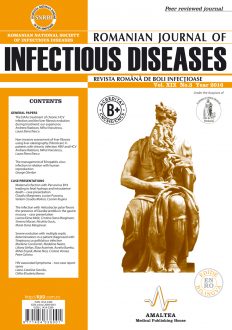SELECT ISSUE

Indexed

| |

|
|
|
| |
|
|
|

|
|
|
|
|
|
| |
|
|
HIGHLIGHTS
National Awards “Science and Research”
NEW! RJID has announced the annually National Award for "Science and Research" for the best scientific articles published throughout the year in the official journal.
Read the Recommendations for the Conduct, Reporting, Editing, and Publication of Scholarly work in Medical Journals.
The published medical research literature is a global public good. Medical journal editors have a social responsibility to promote global health by publishing, whenever possible, research that furthers health worldwide.
SEVERE EVOLUTION WITH MULTIPLE SEPTIC DETERMINATIONS IN A PATIENT DIAGNOSED WITH STREPTOCOCCUS GALLOLYTICUS INFECTION
Marilena Constantin, Mădălina Neața, Liliana Ștefan, Eliza Acatrinei, Aurelia Bumbu, Mihai Enyedi, Maria Nica, Cristina Voinea and Petre Calistru
ABSTRACT
Streptococcus gallolyticus, member of streptococcus bovis group colonizes digestive tubes of birds, cows and human (2.5-15%). Literature describes the association between bacteriemia with Streptococcus gallolyticus and colon tumours but also extracolonic lesions (bacterial endocarditis, vertebral osteomyelitis, dyscitis, colangitis, lung tumors, ovarian tumors).
We report the case of a 60 years old male caucasian patient who was diagnosed with vertebral osteomyelitis as the first lesion of Streptococcus gallolyticus infection identified by blood culture. Other lesions were diagnosed on aortic valve (bacterian endocarditis), right popliteal artery (popliteal artery thrombosis), right knee (arthritis). Even if there was a clinical and biological improvement during the treatment, the imaging tests done after 30 and 45 days from the diagnosis showed severe aortic insuficiency so surgical intervention for aortic valvuloplasty was done in a short time. Vertebral and popliteal artery lesions have improved within two months of antibiotic treatment. Colonoscopy, which was done 6 weeks from the diagnosis showed colonic polyps – risk factors of Streptococcus gallolyticus bacteriemia.
This case proves that Streptococcus gallolyticus infection has a silent period followed by severe evolution by multiple septic lesions inspite of the precocious treatment and warn of the necessity of digestive investigations at these patients.
Keywords: Streptococcus Gallolyticus infection, vertebral osteomyelitis, endocarditis, thromboses
Full text | PDF
